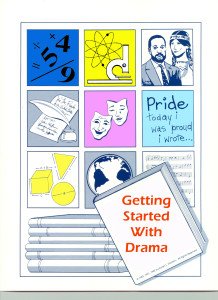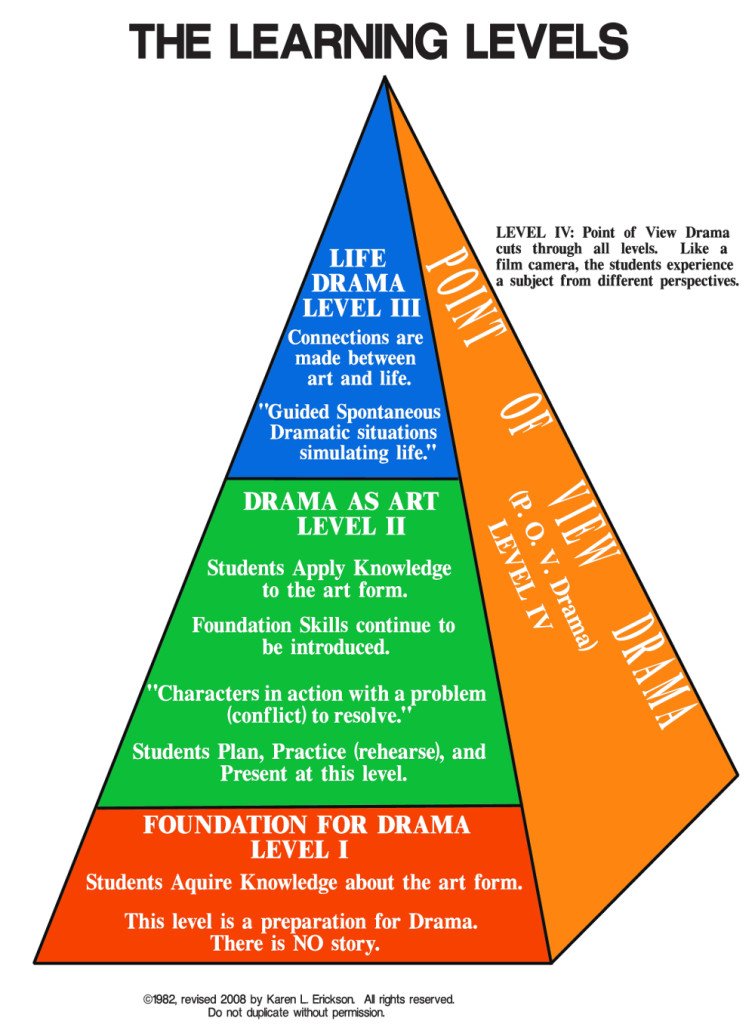 We designed these lessons to introduce the skills and concepts of drama before moving to more integrated work. Begin by teaching these seven introductory lessons which are geared for 1st though 8th graders. Not enough time to teach seven lessons? Then we recommend you download lessons 2-5 and begin with those.
We designed these lessons to introduce the skills and concepts of drama before moving to more integrated work. Begin by teaching these seven introductory lessons which are geared for 1st though 8th graders. Not enough time to teach seven lessons? Then we recommend you download lessons 2-5 and begin with those.
Using these lessons, you can create an entire curriculum, which is aligned to National Standards, including assessments. If you follow these lessons, you will have your first seven lessons planned out for you which is especially helpful for those new to drama.
Before you start, a note about lesson objectives
In most cases, we believe that only one to three objectives can be covered in a 30 to 60 minute lesson. If some objectives have been introduced in a previous lesson, then reviews of skills or concepts might be in order, increasing the number of objectives slightly. Even a good review takes time.
The lessons sometimes have more objectives than we would normally recommend. Why? Because we are trying to quickly set a base of fundamental learning so that you can move to the Grade Level Guides where fewer objectives are covered, with more depth, in each lesson.
Some things you might do:
- You might devise new lessons that repeat learning in a particular skill or concept if you think students need more time to master the content.
- If needed, you might also slow these lessons down, break them into chunks (except for The Circus lesson).
 You might omit an objective the first time you teach a lesson (or portion of a lesson); then repeat the lesson on another day focusing on the omitted objective. In our experience, many classes love doing the lessons and want them repeated. So, why not? Repeat them but focus the conversation, the Debrief and Learn, and the essential question on a skill or concept that needs more attention.
You might omit an objective the first time you teach a lesson (or portion of a lesson); then repeat the lesson on another day focusing on the omitted objective. In our experience, many classes love doing the lessons and want them repeated. So, why not? Repeat them but focus the conversation, the Debrief and Learn, and the essential question on a skill or concept that needs more attention.-
In drama, there is no right way, no wrong way. It is a creative endeavor for both the student and the teacher. Enjoy the work. Build the knowledge and skills and soon the young people will own the art form.
The Introductory Lessons
- Introducing the Five Senses Lesson: this lesson is a good starter lesson that works with the 5 senses (imagery ideas provided). This lesson can also be used with the story The Queen Bee's Dilemma.
- Book, Stick, Chair, Person Lesson: this lesson incorporates activities to assess participants so you can understand their abilities. Use this lesson early on to understand your group dynamics.
- Concentration and Partner Work Lesson: We designed this lesson to teach your group foundational drama skills for concentration and partner work. This lesson sets an important classroom management signal (the "Freeze") and students work with partners to learn collaboration and cooperation.
- Body Objects Lesson: Creating Settings with Details (complementary): this lesson was designed around the simple activity called Body Objects and makes use of the stories B.J.'s Journey, The Dreamer or The Sacred Scarab Root. Other stories can be adapted to this lesson as well.
- The Circus Lesson - Introducing the Three P’s: This lesson introduces your class or group to the three P's: Planning, Practicing, Presenting (or Performing). This lesson requires no additional materials.
- The Hare and Tortoise Lesson - Playing Animal Characters: This lesson is built around the story with the same name: The Tortoise and the Hare. Most people will be familiar with this fable and our version of the story can be found on here along with the integration ideas and skills taught. An alternate story to use with this lesson is How the Earth was Formed on Turtle's Back.
- The Sacred Scarab Lesson - Review & Assess: this lesson builds on the previous six. This is a culminating lesson for the introduction of drama. Most of the lesson is review and/or assessment. If you are not assessing and the class appears ready to advance, you might also use this lesson to introduce or review story elements. It works with the story The Sacred Scarab Root.
To go along with these lessons, you should read about the Getting Started Rubrics. This will provide you assessments to evaluate student's progress. Don't forget to visit our Resources area which has valuable tips and guides to assist you.
Think of the lessons as guides
The lessons are not meant to be prescriptive. They are not meant for you to memorize and deliver in any definitive fashion. They are a guide for you. Alter them, add to them, rearrange them, personalize them, and/or eliminate them as you see fit.
Once you have taught the lesson, we recommend you make notes in the blank column next to the lessons. Highlight items from the lesson you forgot and want to remember to include next time. Draw a line through anything you want to eliminate the next time you teach the lesson. Your lessons can be published on our web site for others to download, just contact us for more information.
If you have experience with or understanding of drama/theater, please create your own personal curriculum with the materials here! Use this site for new ideas. This Getting Started section is for the person who needs a way to begin.



